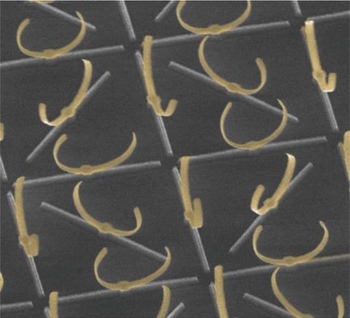
Detail of an SEM image of the fabricated isotropic metamaterial. Each ring is 2.2 µm in diameter. [Image: C.-C. Chen et al., Adv. Opt. Mater., doi: 10.1002/adom.201400316 (2014)]
Metamaterials sporting exotic properties like negative indexes of refraction have been touted for applications ranging from next-generation “superlenses” to optical cloaking devices. But the inherently anisotropic optical response of metamaterials developed thus far has constituted one potential hurdle for practical devices. A team of researchers in Japan and Taiwan now reports the creation—using a novel 3-D split-ring resonator design—of a metamaterial that behaves isotropically at infrared wavelengths (Adv. Opt. Mater., doi: 10.1002/adom.201400316). While only four square millimeters in area, the group’s sample is significantly larger in size than previous attempts at an isotropic metamaterial, and the scientists believe that the new fabrication method could represent an important step toward bringing metamaterials into the mainstream.
The anisotropy of most metamaterials stems from the inherent asymmetry of their constituent “meta-atoms”—the man-made structures that, by interacting in specific ways with light, give these materials their unusual optical properties. To move toward a more isotropic response, the research team took inspiration from the natural world, where isotropic responses can arise from the random arrangement of anisotropic components. One example is a simple glass of water: Though individual water molecules are quite asymmetric, the random orientation of the molecules in the water makes the overall optical response isotropic.
The team fashioned its isotropic metamaterial using a newly developed “metal stress-driven self-folding method.” The method involves deposition of nickel-gold bilayer metal strips in a designed pattern atop a silicon substrate, and the self-folding of those strips into split rings owing to the differential stresses of the metal bilayer (analogous to the bending of the bimetal strip in a traditional thermostat). The result is a carefully structured array of highly uniform split rings. And measurement of the optical response, using spectroscopy and other techniques, showed that it was isotropic for any lateral rotation or polarization for light at a normal incidence angle, and that it maintained its isotropic response for incidence angles up to 40°.
While the reported demo involved a four-square-millimeter flat sample, the scientists say that the fabrication technique could be extended to larger devices by, for example, stacking multiple layers to fashion much more complex, 3-D meta-atoms. Research team leader Takuo Tanuka, of the RIKEN Metamaterials Laboratory, believes that the technique will represent “a breakthrough for bringing the concepts of metamaterials into real components.”
